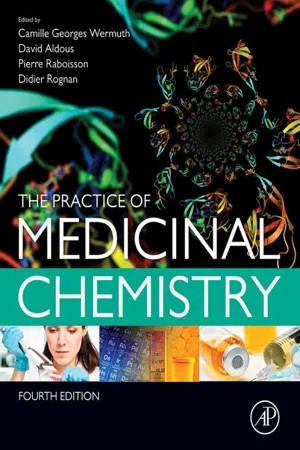
The Practice of Medicinal Chemistry
- 902 pages
- English
- ePUB (mobile friendly)
- Available on iOS & Android
The Practice of Medicinal Chemistry
About this book
The Practice of Medicinal Chemistry, Fourth Edition provides a practical and comprehensive overview of the daily issues facing pharmaceutical researchers and chemists. In addition to its thorough treatment of basic medicinal chemistry principles, this updated edition has been revised to provide new and expanded coverage of the latest technologies and approaches in drug discovery.With topics like high content screening, scoring, docking, binding free energy calculations, polypharmacology, QSAR, chemical collections and databases, and much more, this book is the go-to reference for all academic and pharmaceutical researchers who need a complete understanding of medicinal chemistry and its application to drug discovery and development.- Includes updated and expanded material on systems biology, chemogenomics, computer-aided drug design, and other important recent advances in the field- Incorporates extensive color figures, case studies, and practical examples to help users gain a further understanding of key concepts- Provides high-quality content in a comprehensive manner, including contributions from international chapter authors to illustrate the global nature of medicinal chemistry and drug development research- An image bank is available for instructors at www.textbooks.elsevier.com
Frequently asked questions
- Essential is ideal for learners and professionals who enjoy exploring a wide range of subjects. Access the Essential Library with 800,000+ trusted titles and best-sellers across business, personal growth, and the humanities. Includes unlimited reading time and Standard Read Aloud voice.
- Complete: Perfect for advanced learners and researchers needing full, unrestricted access. Unlock 1.4M+ books across hundreds of subjects, including academic and specialized titles. The Complete Plan also includes advanced features like Premium Read Aloud and Research Assistant.
Please note we cannot support devices running on iOS 13 and Android 7 or earlier. Learn more about using the app.
Information
Strategies in the Search for New Lead Compounds or Original Working Hypotheses
Keywords
I Introduction
A Hits and Leads
B The Main Hit or Lead Finding Strategies
II First Strategy: Analog Design
Table of contents
- Cover image
- Title page
- Table of Contents
- Copyright
- List of Contributors
- Foreword
- Preface to the Fourth Edition
- Preface to the Third Edition
- Preface to the Second Edition
- Preface to the First Edition
- Section I: General Aspects of Medicinal Chemistry
- Section II: Lead Compound Discovery Strategies
- Section III: Primary Exploration of Structure-Activity Relationships
- Section IV: Substituents and Functions
- Section V: Spatial Organization, Receptor Mapping and Molecular Modeling
- Section VI: Chemical Modifications Influencing the Pharmacokinetic Properties
- Section VII: Pharmaceutical and Chemical Means to Solubility and Formulation Problems
- Index